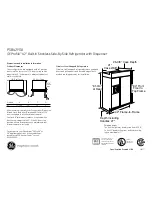
Electrical Maintenance (Rev. 04/03)
58
Troubleshooting Chart
NOTE: All amperage and voltage measurements should be taken with the unit turned ON and the motor running or
attempting to start. Most of the voltage measurements can be taken inside the unit control box, from the components in the
high voltage tray and from the test point strip. The voltage measurements associated with the components under the motor
pedestal should be taken at the test point strip before checking the components and connections under the pedestal. The
overload relay will trip if the motor does not start shortly after the motor contactor is energized.
PROBLEM/PROBABLE CAUSE
TEST/SOLUTION
Motor Does Not Start/Low Line Voltage
Check the power supply voltage at L1 and L2. The voltage
should be between 195 and 230 volts. If not, check the power
cord, the plug, and the main building power supply. / Repair as
necessary.
Motor Contactor
Check to see that the motor contactor closes when energized. If
not, check the control circuit and control coil. If the contactor
closes, check the voltage between L1A and L2A and between
L1A and T3. If either voltage is low, inspect the connector for
burned or pitted points. / Replace the contactor or points as
necessary.
Motor Overload Relay
Check the overload relay to see if it is tripped. / Reset the relay.
(The correct setting for the overload relay is 18 amps.) Check
the current if the relay continues to trip. / Repair the cause of the
overload. Check the voltage between T1 and L2B and between
T1 and T2. If either voltage is low, check the overload relay for
burned or pitted points. / Replace the overload relay or points as
necessary.
Motor Faulty
Test the motor by disconnecting the T1, T2, T2A, T3E, and T3F
wires from the motor and connecting three-phase power directly
to the motor. Connect L1 to leads 1 and 7, connect L2 to leads 2
and 8, and connect L3 to leads 3 and 9. If the motor starts and
runs under a load, the current should not exceed 14.5 amps per
leg. / Replace the motor if it does not run or if the current is too
high.
NOTE: With the phase converter connected to the motor,
the current per leg will vary with the line voltage and, in
general, will not be the same in all legs.
Содержание KD-II SR
Страница 4: ......
Страница 8: ......
Страница 13: ...Safety Precautions Rev 04 03 v AEA40...
Страница 14: ...Safety Precautions Rev 04 03 vi AEA38...
Страница 33: ...Unit Description Rev 04 03 19 1 Evaporator 2 Access Door Rear View Curbside KD II SR 1 2 AEA38...
Страница 37: ...Unit Description Rev 04 03 23 Power Receptacle Box KD II SR 50 AEA42...
Страница 38: ...Unit Description Rev 04 03 24 1 Keypad 2 LED Display THERMOGUARD Remote Control Panel AEA43 1 2...
Страница 42: ...P T System Description Rev 04 03 28 High Voltage Tray No Options High Voltage Tray with Phase Correction...
Страница 44: ...P T System Description Rev 04 03 30 High Voltage Tray with Single Phase Power and Electric Heater...
Страница 58: ...Remote Control Panel Features Rev 04 03 44...
Страница 112: ...Refrigeration Maintenance Rev 04 03 98...
Страница 120: ...106...
Страница 146: ...132...
Страница 156: ...142...
Страница 162: ...148...
Страница 170: ...156...
Страница 172: ...158...
Страница 173: ...159 KD II 30 Schematic Diagram Page 1 of 2...
Страница 174: ...160 KD II 30 Schematic Diagram Page 2 of 2...
Страница 175: ...161 KD II 30 Wiring Diagram Page 1 of 2...
Страница 176: ...162 KD II 30 Wiring Diagram Page 2 of 2...
Страница 177: ...163 KD II 50 Schematic Diagram Page 1 of 2...
Страница 178: ...164 KD II 50 Schematic Diagram Page 2 of 2...
Страница 179: ...165 KD II 50 Wiring Diagram Page 1 of 2...
Страница 180: ...166 KD II 50 Wiring Diagram Page 2 of 2...
Страница 181: ...167 KD II 50 SR 230 1 60 Wiring Diagram Page 1 of 2...
Страница 182: ...168 KD II 50 SR 230 1 60 Wiring Diagram Page 2 of 2...
















































